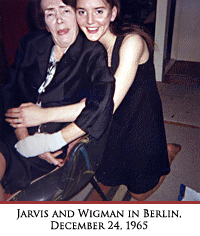 | ||||||||
Mary is ... extremely wise, and a genius ... She says each one of us is an individual, that we are to discover ourselves. If we come to a point where we have to begin again, she said we could give up, but that by beginning again we really have a second beginning, which is at a higher level ... it's hard to tell you of her, because her words are so deep and heavy. She is a great person. Wigman's near-mystical vision of the deep soul of the dance radiates from the pages of her writing. As a dancer, she had been a channel for profound connections of emotion and ego. Through its deeply personal nature her dance reached for a universality which has been attained by few dance artists. "Breath" was a central movement principle taught by Wigman and indeed breath became the key, the crux, the emblem of Judy Jarvis' dance. A dancer in Judy's company recalled Judy teaching them breathing rituals she had learned from Wigman. Breath was always an important fundamental element of Judy's own teaching. Frau Thiele, a teacher who worked with Wigman for thirty years, listed the study of rhythm ("tanz gymnastic"), music, anatomy, composition and art history as making up the School's curriculum. Students were encouraged to learn to teach with language alone by sometimes having to conduct classes sitting down, rather than demonstrating through movement. They were required to write and speak once a month about themes given by Wigman. In this way the integration of experience and understanding which marked Mary Wigman's illuminations about dance was fostered in each dancer. For Judy, writing her thoughts about dance became an essential part of her flow of ideas, of investigating her creative process, a private pouring out of her deepest thoughts and impulses.
Christmas was very important in the German social year. Regular life was disrupted. Knowing that the Wigman School closed from early December to January, Judy became restless. Wanting to travel in Europe, she somehow financed a student tour to Munich, Italy and Switzerland. On her return, Berlin was bitterly cold, comfortless. Huddled in her chilly room, Judy started to think of her future in the early days of 1966. She wanted to attend the annual Summer Course in Cologne. She wrote to her mother that it would work out well, as it opened right after the Wigman School closed on July 10 and cost only the equivalent of $16. Then she hoped to travel to Greece with two friends who attended the School and she also wanted to travel to London and study at the Laban Centre. Judy was anxious about her long-term future too. All her life, she seemed to lead a dance between needing the security that institutions represented to her, working and studying in them, and at the same time willfully seeking personal freedom in a flow of challenge and change. In a placating letter to her mother, possibly lulled by the kind of acceptance and respect dance found in Berlin, she wrote: I never realized it in Canada but dance is one of the most secure professions a girl can have. In a university I could choreograph, teach and perform myself ... with all the necessities supplied and paid for ...
Last Monday, we performed a solo sketch composition of "Ophelia". Mary, who criticizes our work, said mine was perfect! Everyone here liked it and I did it twice for them. Mary praised me to the skies, but warned me not to get vain. You don't know how I've changed, Mom. I'm more shapely, my features are softer, my hair is thicker and shinier, and I am beginning to become a dancer. Also my skin has cleared up and I even laugh a lot more. If I have to stop dancing, you don't know what it would do to me.
©2005, Dance Collection Danse | ||
 The last incarnation of the Wigman school became a spiritual home for Judy Jarvis who was eager to soak up the half century of wisdom accumulated by the European "grand master" of modern dance. Judy would be a student of Mary Wigman's for the last two years that this school operated.
The last incarnation of the Wigman school became a spiritual home for Judy Jarvis who was eager to soak up the half century of wisdom accumulated by the European "grand master" of modern dance. Judy would be a student of Mary Wigman's for the last two years that this school operated. Wigman believed that a creation must speak of the artist's personality. The philosophy of individual expression in art took root in Judy's lonely, determined quest to dance. At the Wigman School Judy found a teaching philosophy which fired her creative aspirations and guided her toward the molding of her body as a dancing instrument. Of Mary Wigman herself Judy made a teacher, a guide, a goddess of wisdom, a personal critic, a mother, a mentor. This investment of Mary with enormous power was to be both a source of strength and inspiration to Judy, and in time a condition of her own creative unfolding.
Wigman believed that a creation must speak of the artist's personality. The philosophy of individual expression in art took root in Judy's lonely, determined quest to dance. At the Wigman School Judy found a teaching philosophy which fired her creative aspirations and guided her toward the molding of her body as a dancing instrument. Of Mary Wigman herself Judy made a teacher, a guide, a goddess of wisdom, a personal critic, a mother, a mentor. This investment of Mary with enormous power was to be both a source of strength and inspiration to Judy, and in time a condition of her own creative unfolding.


